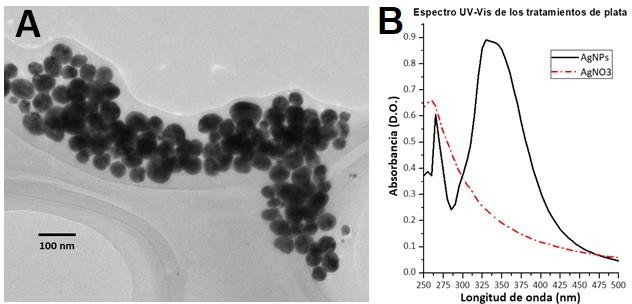Nanopartículas de plata como nanoantibióticos: Un análisis comparativo de su toxicidad en sistemas biológicos de diferente complejidad
DOI:
https://doi.org/10.37636/recit.v11811Palabras clave:
Nanopartículas de Plata, Nanotoxicología, Complejidad de Sistemas Biológicos, Actividad AntimicrobianaResumen
Actualmente, las nanopartículas de plata (AgNPs) se estudian ampliamente para aplicaciones biomédicas, pero a pesar de que los nanomateriales proporcionan muchos beneficios, recientemente su toxicidad comparativa apenas se ha explorado. En el trabajo actual, la toxicidad de AgNPs en sistemas biológicos de diferentes niveles de complejidad se evaluó de forma exhaustiva y comparativa. Los organismos incluyen virus, bacterias, microalgas, hongos, células animales y humanas (incluidas líneas celulares cancerosas). Encontramos que el crecimiento de los sistemas biológicos de diferentes grupos taxonómicos -in vitro, a nivel celular- se inhibe a concentraciones de AgNP dentro del mismo orden de magnitud (101 μg / ml). Por lo tanto, la toxicidad de AgNPs no depende de la complejidad de los organismos. El hecho de que las células y los virus se inhiban con una concentración de AgNP dentro del mismo orden de magnitud podría explicarse teniendo en cuenta que la plata afecta las estructuras fundamentales de las células y virus por igual.Descargas
Citas
H. H. Lara, E. N. Garza-Treviño, L. Ixtepan- Turrent, and D. K. Singh, "Silver nanoparticles are broad-spectrum bactericidal and virucidal compounds.," J. Nanobiotechnology, vol. 9, p. 30, 2011. https://doi.org/10.1186/1477-3155-9-30 DOI: https://doi.org/10.1186/1477-3155-9-30
G. Franci, A. Falanga, S. Galdiero, L. Palomba, and M. Rai, "Silver nanoparticles as potential antibacterial agents," Molecules, 2015. https://doi.org/10.3390/molecules20058856 DOI: https://doi.org/10.3390/molecules20058856
J. Il Kwak and Y.-J. An, "Trophic transfer of silver nanoparticles from earthworms disrupts the locomotion of springtails (Collembola)," J. Hazard. Mater., May 2016. https://doi.org/10.1016/j.jhazmat.2016.05.005 DOI: https://doi.org/10.1016/j.jhazmat.2016.05.005
F. Martinez-Gutierrez, P. L. Olive, A. Banuelos, E. Orrantia, N. Nino, E. M. Sanchez, F. Ruiz, H. Bach, and Y. Av-Gay, "Synthesis, characterization, and evaluation of antimicrobial and cytotoxic effect of silver and titanium nanoparticles," Nanomedicine Nanotechnology, Biol. Med., vol. 6, no. 5, pp. 681-688, 2010. https://doi.org/10.1016/j.nano.2010.02.001 DOI: https://doi.org/10.1016/j.nano.2010.02.001
A. Panáček, M. Kolář, R. Večeřová, R. Prucek, J. Soukupová, V. Kryštof, P. Hamal, R. Zbořil, and L. Kvítek, "Antifungal activity of silver nanoparticles against Candida spp.," Biomaterials, vol. 30, no. 31, pp. 6333-6340, 2009. https://doi.org/10.1016/j.biomaterials.2009.07.065 DOI: https://doi.org/10.1016/j.biomaterials.2009.07.065
F. Seitz, R. R. Rosenfeldt, K. Storm, G. Metreveli, G. E. Schaumann, R. Schulz, and M. Bundschuh, "Effects of silver nanoparticle properties, media pH and dissolved organic matter on toxicity to Daphnia magna," Ecotoxicol. Environ. Saf., vol. 111, pp. 263-270, 2015. https://doi.org/10.1016/j.ecoenv.2014.09.031 DOI: https://doi.org/10.1016/j.ecoenv.2014.09.031
C. Greulich, D. Braun, A. Peetsch, J. Diendorf, B. Siebers, M. Epple, and M. Köller, "The toxic effect of silver ions and silver nanoparticles towards bacteria and human cells occurs in the same concentration range," RSC Advances, vol. 2, no. 17. p. 6981, 2012. https://doi.org/10.1039/c2ra20684f DOI: https://doi.org/10.1039/c2ra20684f
J. You, Y. Zhang, and Z. Hu, "Bacteria and bacteriophage inactivation by silver and zinc oxide nanoparticles," Colloids Surfaces B Biointerfaces, vol. 85, no. 2, pp. 161-167, 2011. https://doi.org/10.1016/j.colsurfb.2011.02.023 DOI: https://doi.org/10.1016/j.colsurfb.2011.02.023
S. Ghosh, R. Kaushik, K. Nagalakshmi, S. L. Hoti, G. a. Menezes, B. N. Harish, and H. N. Vasan, "Antimicrobial activity of highly stable silver nanoparticles embedded in agar- agar matrix as a thin film," Carbohydr. Res., vol. 345, no. 15, pp. 2220-2227, 2010. https://doi.org/10.1016/j.carres.2010.08.001 DOI: https://doi.org/10.1016/j.carres.2010.08.001
T. Mosmann, "Rapid colorimetric assay for cellular growth and survival: application to proliferation and cytotoxicity assays.," J. Immunol. Methods, vol. 65, no. 1-2, pp. 55- 63, Dec. 1983. https://doi.org/10.1016/0022-1759(83)90303-4 DOI: https://doi.org/10.1016/0022-1759(83)90303-4
Vazquez-Muñoz, R., Borrego, B., Juárez- Moreno, K., García-García, M., Mota Morales, J. D., Bogdanchikova, N., & Huerta-Saquero, A. (2017). Toxicity of silver nanoparticles in biological systems: Does the complexity of biological systems matter? Toxicology Letters, 276, 11-20. https://doi.org/10.1016/j.toxlet.2017.05.007 DOI: https://doi.org/10.1016/j.toxlet.2017.05.007

Descargas
Publicado
Cómo citar
Número
Sección
Categorías
Licencia
Derechos de autor 2018 Roberto Vázquez-Muñoz, Belén Borrego-Rivero, Karla Oyuky Juárez-Moreno, Maritza Roxana García-García, Josué David Mota-Morales, Nina Bogdanchikova, Alejandro Huerta-Saquero

Esta obra está bajo una licencia internacional Creative Commons Atribución 4.0.
Los autores/as que publiquen en esta revista aceptan las siguientes condiciones:
- Los autores/as conservan los derechos de autor y ceden a la revista el derecho de la primera publicación, con el trabajo registrado con la licencia de atribución de Creative Commons 4.0, que permite a terceros utilizar lo publicado siempre que mencionen la autoría del trabajo y a la primera publicación en esta revista.
- Los autores/as pueden realizar otros acuerdos contractuales independientes y adicionales para la distribución no exclusiva de la versión del artículo publicado en esta revista (p. ej., incluirlo en un repositorio institucional o publicarlo en un libro) siempre que indiquen claramente que el trabajo se publicó por primera vez en esta revista.
- Se permite y recomienda a los autores/as a compartir su trabajo en línea (por ejemplo: en repositorios institucionales o páginas web personales) antes y durante el proceso de envío del manuscrito, ya que puede conducir a intercambios productivos, a una mayor y más rápida citación del trabajo publicado (vea The Effect of Open Access).











